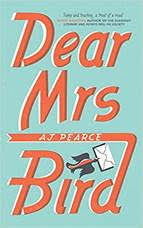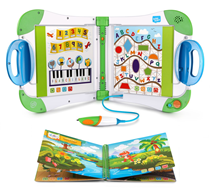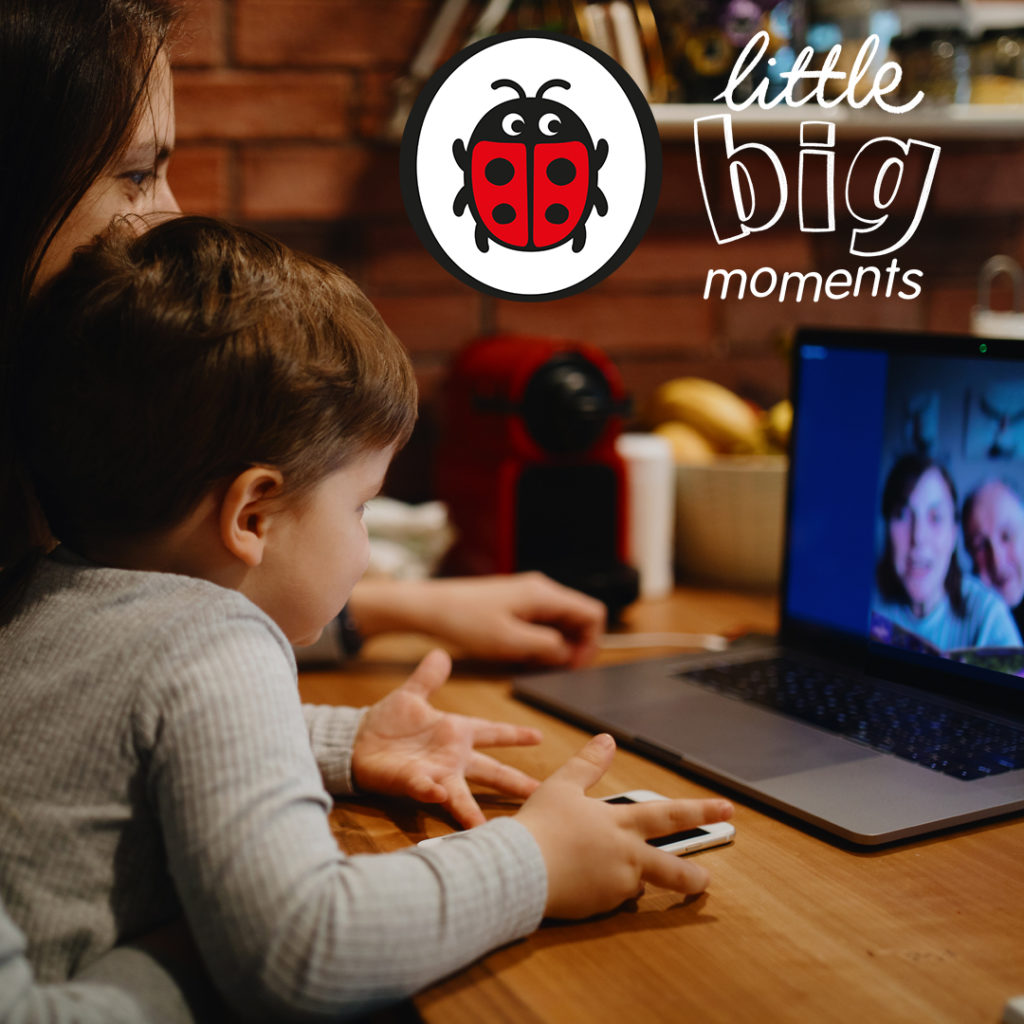Wondering how to keep up your healthy new habits as lockdown rules begin to ease, Joe Wicks aka The Body Coach has shared his top tips on keeping a healthy mind and body – plus 4 tasty recipes!
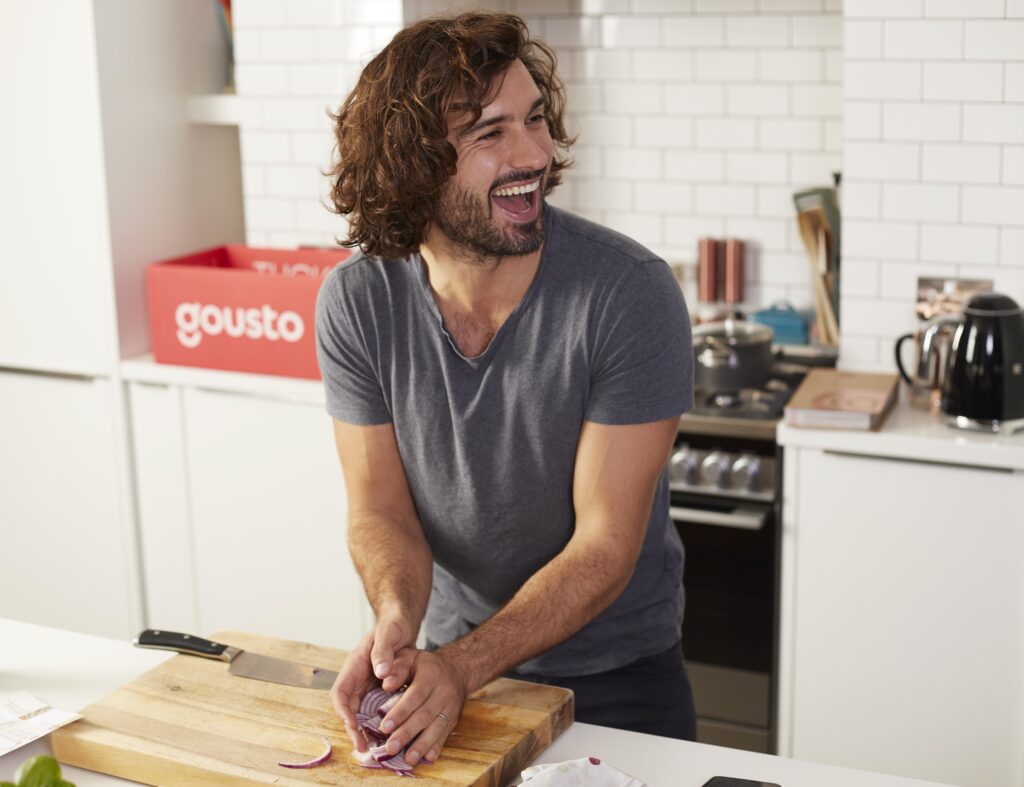
The tips accompany a new study by food box company Gousto which reveals that 58% of Brits have made a more conscious effort to get active during lockdown.
“The nation’s PE teacher”, Joe Wicks has put together 8 of his top tips to make it easier to stay healthy and motivated at home, plus four new healthy eating recipes!
Gousto’s recent study on lockdown habits in Britain reveals:
- A quarter of Brits have formed new positive habits
- 95% of those are aiming to sustain their new habits after lockdown
- Cooking fresh food at home tops the list of new habits that are here to stay
- Research by Gousto discovered over 25% of Brits will continue working out at home, rather than pay for a gym membership
8 Tips For Staying Healthy This Summer From Joe Wicks
It’s an uncertain time for everyone at the moment, so it can be really difficult to put your mental and physical well being first. My top tips for you this summer are all about making long-term lifestyle changes.
There are loads of amazing activities people have been getting involved in during the lockdown with more people cooking and walking than ever before… and there’s no reason why this should change. If you’re someone who’s struggled to find a healthy balance during this time, I hope these tips will get you going!
Give them a go and they’ll transform how healthy you are and how you feel physically and mentally.
Make the most of your home
You don’t need a gym or lots of equipment to get fit and healthy. Lots of people have been getting creative and finding space at home for exercise. I’ve always believed in the power of home workouts because it’s so much easier to maintain a daily routine when you’re exercising on your own terms. I’m a big fan of HIIT training and you can do it anywhere; at home, in the garden or even in the park.
Rise and shine
I love to exercise first thing in the morning, it wakes me up, boosts my energy and sets me up to win the day. It’s also a perfect way to make the most of the longer days. Plan your workouts in advance and try and stick to them like appointments you can’t miss. If you can’t train in the morning, that’s fine, it’s all about finding what works for you. Remember, whatever time of day you exercise, it’s going to make you feel awesome physically and mentally.
Keep cooking
Cooking at home with fresh ingredients means you know what’s going into your food. You can have loads of fun experimenting with different recipes and that’s one of the things I love about Gousto. You have 50 recipes at your fingertips every week, including four from my new Lean in 15 range. The new recipes combine high carb, post workout recipes with low carb recipes for less active days, so there’s always a banging, balanced recipe to try.
Make exercise fun
Exercise should be fun, not something you dread. We’ve all found new ways to workout during lockdown and most don’t need equipment, or even much time. Put some fun into your routine: do a HIIT workout in the front room, walk a new route, offer to walk a neighbour’s dog or go for a run with someone from your household. It doesn’t matter what exercise you do, find something you enjoy and you’ll find it much easier to stick to.
Get some fresh air
I love getting outside and going for a long walk in the summer. We’re all finding a new appreciation for getting outside, so try to keep that going as we get back to normal. Get out into the garden or find a local, quiet space to do your workout. If you’re not feeling a heavy workout every day, a light walk and some fresh air will still make you feel great.
Don’t fear the carbs
Carbs give you energy, help your brain function and give your muscles fuel to recover after a workout. Carbs are not the enemy, so don’t be afraid of them, I like to refuel with a high carb meal after a workout. Try my Creamy Chickpea Curry Loaded Sweet Potato recipe after you exercise. On days that you’re not as active, give my lower carb recipes a go, like my Cheesy Pizza Topped Chicken With Mixed Salad. Both recipes are part of my new Lean in 15 range with Gousto.
Find a balance
Cutting any food group or depriving yourself of the foods that you love is not sustainable. If you make balanced food choices most of the time and stay active, you absolutely shouldn’t feel guilty about treating yourself to an indulgent meal or a delicious dessert.
Make the time
So many people are super busy at the moment, juggling home working, childcare, home schooling and other responsibilities. Other people are finding they have more time on their hands than ever before. As our routines change all over again, it’s important to make time to look after yourself. Quick daily workouts and easy home cooking are a great place to start.
No matter what pressures you’re feeling during this time, be healthy on your terms. Find exercises that get you up in the morning, food that you’re excited to eat and make goals that work around your lifestyle.
4 Healthy Eating Recipes, From Joe Wicks & Gousto’s Lean in 15 range
Cheesy Pizza-Topped Chicken with Mixed Salad (Low Carb)
“You’ll get that cheesy tomato pizza goodness by topping British chicken breast with rich tomato sauce and melty mozzarella. Serve it with a creamy dressed side salad!” – Joe Wicks.
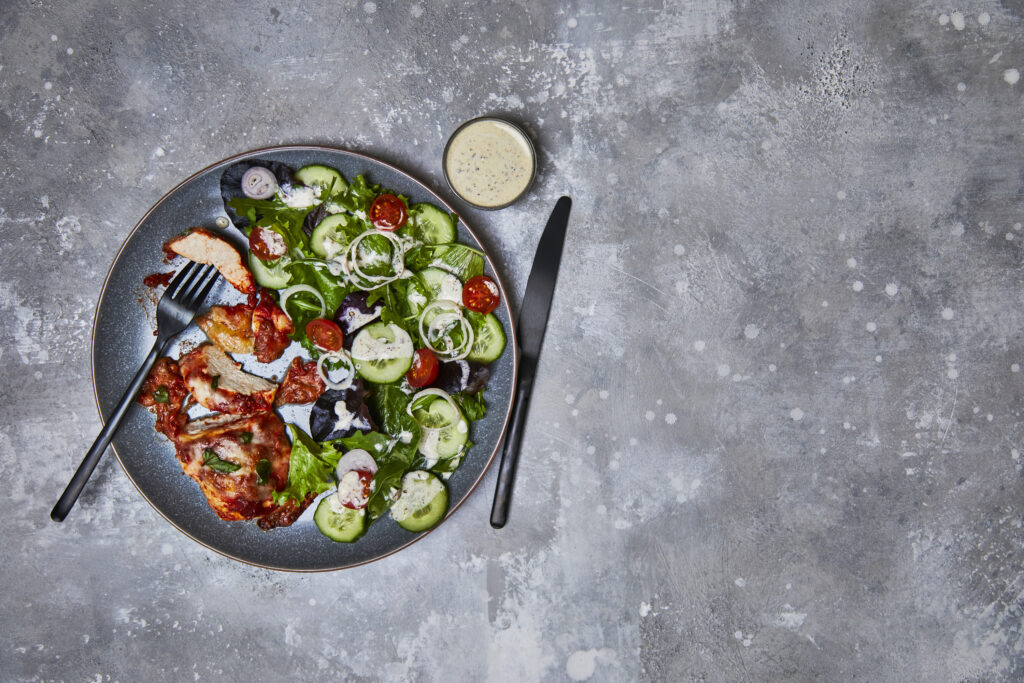
Ingredients (Serves 2)
1 shallot
1/2 cucumber
1 mozzarella ball (125g)
125g cherry tomatoes
50g baby leaf salad
1 tsp dried oregano
5g basil
15ml white wine vinegar
32g tomato paste
30ml mayonnaise
2 British chicken breast fillets
Method
Step 1: Preheat the oven to 220°C/ 200°C (fan)/ 425°F/ Gas 7. Add the chicken breasts to a baking tray (use tin foil to avoid mess!)
Step 2: Peel and finely chop (or grate) the garlic. Combine the tomato paste, chopped garlic and a pinch of the dried oregano with 1 tbsp [2 tbsp] water and a pinch of salt – this is your pizza sauce.
Step 3: Drain and pat the mozzarella dry with kitchen paper. Tear the drained mozzarella into rough, bite-sized pieces Tear the basil leaves roughly.
Step 4: Spread the pizza sauce over the chicken breasts. Top with the torn mozzarella. Sprinkle over the torn basil leaves
Step 5: Put the tray in the oven for 15-20 min or until the chicken is cooked through (no pink meat!) and the mozzarella is melted and golden.
Step 6: Whilst the chicken is cooking, chop the cherry tomatoes in half. Slice the cucumber finely, and peel and slice the shallot[s] as finely as you can. Then add the chopped cherry tomatoes, sliced cucumber and sliced shallot to a large bowl with the baby leaf salad and give it a gentle mix up – this is your mixed salad.
Step 7: Combine the mayonnaise, white wine vinegar and remaining dried oregano with 1 tbsp olive oil and a pinch of salt and pepper – this is your creamy dressing.
Step 8: Serve the cheesy pizza-topped chicken with the mixed salad to the side. Drizzle the creamy dressing all over the salad. Winner!
Creamy Chickpea Curry Loaded Sweet Potato (Carb Refuel)
“Creamy, coconutty chickpea curry tastes so good piled into a baked sweet potato. Top it off with cashews, red chillies and a sprinkle of coriander for plant-based, Indian fusion at it’s best!” – Joe Wicks.
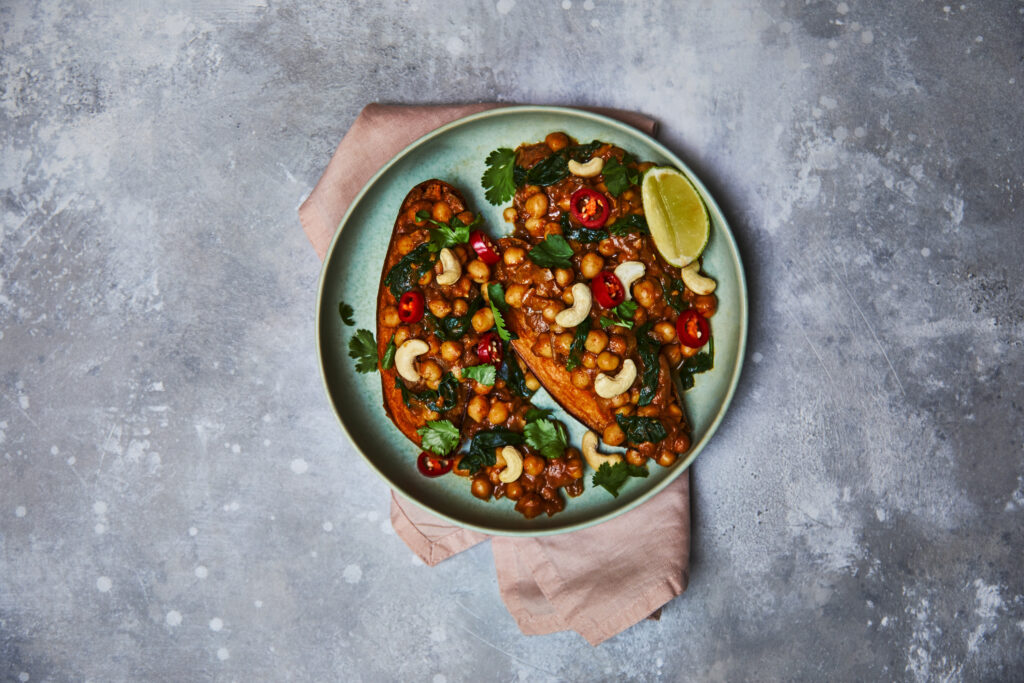
Ingredients (Serves 2)
1 brown onion
1 red chilli
1 lime
1 garlic clove
15g fresh root ginger
25g cashew nuts
5g coriander
120g baby leaf spinach
1 tbsp korma curry powder
1/2 Knorr vegetable stock cube
2 medium sweet potatoes
16g tomato paste
25g solid coconut cream
1 can of chickpeas (400g)
Method
Step 1: Preheat the oven to 220°C/ 200°C (fan)/ 425°F/ Gas 7. Pierce the sweet potatoes with a fork, then cook in the microwave for 5-7 min or until slightly softened. Transfer the sweet potatoes to a baking tray with a drizzle of vegetable oil and a generous pinch of salt then put the tray in the oven and cook for 12-15 min or until the skin is crispy.
Step 2: Meanwhile, boil half a kettle. Peel and finely chop the brown onion, ginger and garlic.
Step 3: Heat a large, wide-based pan (preferably non-stick) with 1 tbsp [2 tbsp] vegetable oil over a medium heat. Once hot, add the chopped onion with a pinch of salt and cook for 4-6 min or until softened. Then add the chopped ginger, chopped garlic and korma curry powder, and cook for 1-2 more minutes.
Step 4: Whilst the onion is softening, dissolve 1/2 Knorr vegetable stock cube and the coconut cream in 200ml boiled water. Add the tomato paste and stir it all together – this is your coconut stock.
Step 5: Drain and rinse the chickpeas, then add the coconut stock and drained chickpeas to your pan and cook for 4-5 min or until the sauce has thickened.
Step 6: Meanwhile, wash the spinach, then add it to a colander and pour boiled water all over it so that it starts to wilt. Rinse the wilted spinach under the cold tap until it’s cool, then squeeze as much water out of it as you can.
Step 7: Once the curry has thickened, add the wilted spinach and the juice of 1/2 lime – this is your chickpea curry.
Step 8: Once the potatoes are cooked, add the cashew nuts to the tray and return it to the oven for a further 2-3 min or until the cashews are golden and toasted.
Top tip! Watch them like a hawk so they don’t burn.
Step 9: Slice the red chilli[es] into rounds. Chop the coriander roughly, including the stalks and cut the remaining lime into wedges.
Step 10: Cut the sweet potatoes in half, lengthways, and fill with the chickpea curry. Garnish with the chilli rounds, chopped coriander, toasted cashew nuts and a lime wedge – bosh!
Spicy Chicken Chilli with Feta & Avocado (Carb Refuel)
“This fiery chilli is absolutely banging! You’ll shred spiced chicken and stir it into a smoky chipotle chilli sauce with creamy black beans. Serve it with a feta and avo salsa and brown rice. Hot stuff!” – Joe Wicks.
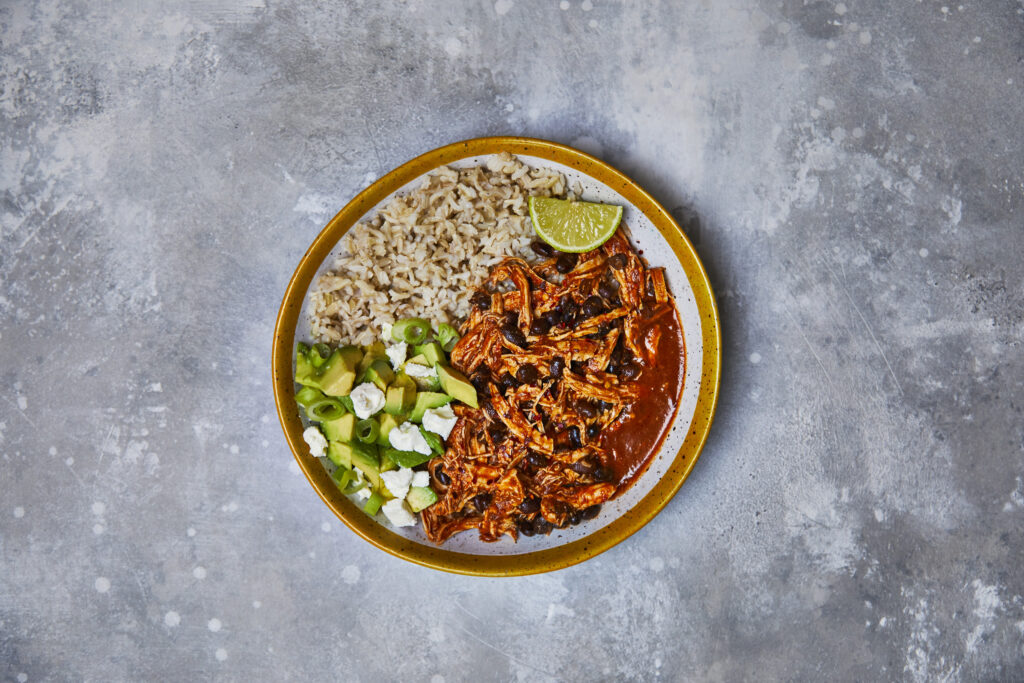
Ingredients (Serves 2)
1 lime
1 garlic clove
1 spring onion
1 tsp smoked paprika
1 tsp ground cumin
1/2 tsp dried chilli flakes
100g brown rice
20g chipotle paste
1 avocado
30g Greek feta cheese
32g tomato paste
1 can of black beans
2 British chicken breast fillets
Method
Step 1: Boil half a kettle. Meanwhile, rinse the brown rice, add it to a pot with plenty of cold water and bring to the boil over a high heat. Once boiling, reduce the heat to medium and cook for 15-20 min or until it’s tender with a slight bite. Once the rice is cooked, drain, return it to the pot and keep covered until serving
Step 2: Add the smoked paprika and ground cumin to a plate with a pinch of salt and 1/2 tbsp vegetable oil. Mix it all up, then add the chicken breasts and turn until well coated.
Step 3: Heat a large, wide-based pan (preferably non-stick, with a matching lid) over a high heat with 1/2 tbsp [1 tbsp] vegetable oil. Once hot, add the coated chicken breasts and cook for 3 min on each side or until browned
Step 4: Whilst the chicken is browning, peel and finely chop (or grate) the garlic. Dissolve the tomato paste in 200ml boiled water and add the chipotle paste (can’t handle the heat? Use half!) – this is your chipotle stock.
Step 5: Drain and rinse the black beans. Once the chicken has browned, add the garlic and cook for 30 seconds. Add the chipotle stock, drained black beans and chilli flakes and bring to the boil. Then cook, covered, for a further 12-15 min or until the chicken is cooked through (no pink meat!) and the sauce has thickened.
Step 6: Cut the avocado in half lengthways, around the stone, remove the flesh and dice roughly. Trim, then slice the spring onion and crumble the feta into large pieces. Cut the lime in half.
Step 7: Combine the chopped avocado, crumbled feta and sliced spring onion in a small bowl with the juice of 1/2 lime and stir it all together – this is your feta & avocado salsa. Cut the remaining lime into wedges
Step 8: Once the chicken is cooked, transfer it to a clean board and pull and shred apart using two forks. Return the shredded chicken to the sauce and give everything a good mix up – this is your chicken chilli.
Step 9: Serve the chicken chilli with the brown rice and feta & avocado salsa to the side. Bangin’!
Miso Tofu with Stir-Fried Ginger Greens (Low Carb)
“I’ve packed heaps of flavour into protein-packed tofu with this super easy miso mirin glaze that’s full of umami. For lean, low-carb satisfaction, serve it with ginger and garlic stir-fried greens.” – Joe Wicks.
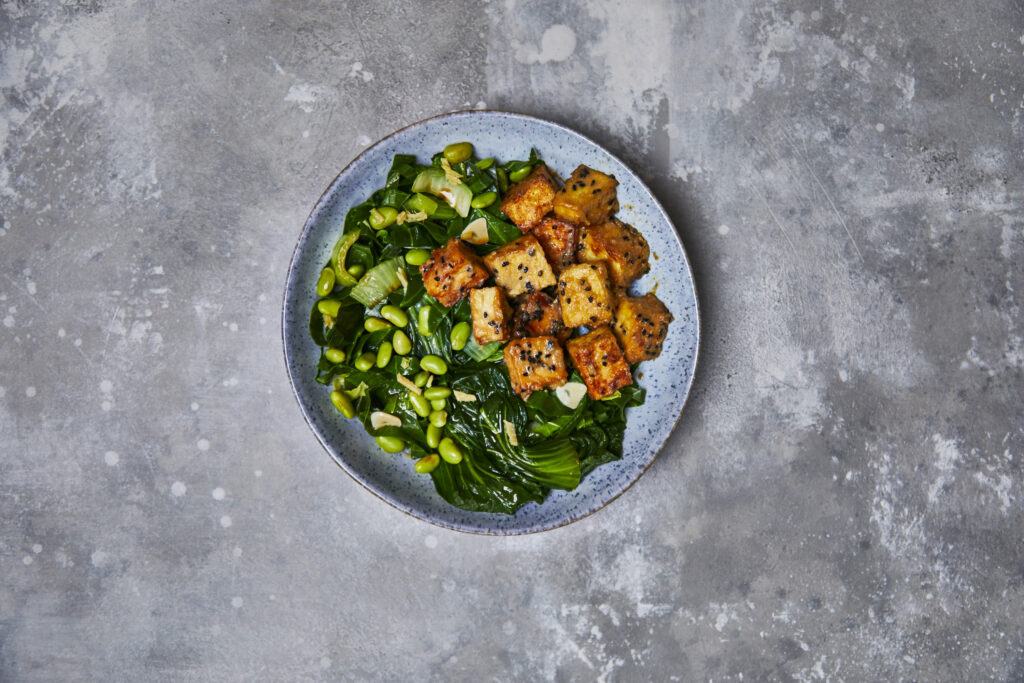
Ingredients (Serves 2)
1 garlic clove
15g fresh root ginger
8g soy sauce
2 tbsp white miso paste
200g pak choi
150g spring greens
280g plain tofu
15ml mirin
5g black sesame seed
80g blanched edamame beans
Method
Step 1: Boil half a kettle. Drain the tofu and pat it dry with kitchen paper, then cut the tofu into cubes.
Step 2: Rip the leaves off the spring greens, discard the tough stalks, then layer the leaves over each other, roll them up and slice into thin strips.
Step 3: Cut the pak choi in half, separating the white bases and green tops. Then cut the white bases into bite-sized pieces.
Step 4: Put the edamame beans in a bowl and cover with boiled water.
Step 5: Add the miso paste and mirin to a small bowl with 1 tbsp vegetable oil and mix until smooth – this is your miso glaze.
Step 6: Peel and finely slice (don’t chop!) the garlic and peel and finely chop the ginger into batons.
Step 7: Heat a large, wide-based pan (preferably non-stick) with 1 tbsp vegetable oil over a high heat. Once hot, add the tofu cubes and cook for 5-6 min or until browned all over and starting to crisp
Step 8: Meanwhile, heat a separate wide-based pan (preferably non-stick) with 1 tbsp vegetable oil over a medium-high heat. Once hot, add the shredded spring greens and pak choi bases and cook for 2-3 min or until starting to wilt.
Step 9: Drain, then add the edamame beans, pak choi tops and chopped ginger and garlic to the greens and cook for a further 2-3 min or until fragrant and everything is tender with a bite.
Step 10: Add the soy sauce and give everything a good mix up – these are your stir-fried ginger greens.
Step 11: Once the tofu is golden, add the miso glaze and cook for 2-3 min or until the sauce has coated the tofu and starting to caramelise.
Step 12: Sprinkle over the black sesame seeds and serve the miso tofu with the stir-fried ginger greens to the side. Get in!
 Earlier this year, designer and shop owner Eleanor Tattersfield – who runs Marby & Elm, a print workshop and stationery store on Exmouth Market, London – put out a call on Instagram: ‘I’ll send you a postcard, you send me a secret’. What transpired was a feeling of togetherness and community between women from all backgrounds.
Earlier this year, designer and shop owner Eleanor Tattersfield – who runs Marby & Elm, a print workshop and stationery store on Exmouth Market, London – put out a call on Instagram: ‘I’ll send you a postcard, you send me a secret’. What transpired was a feeling of togetherness and community between women from all backgrounds.



